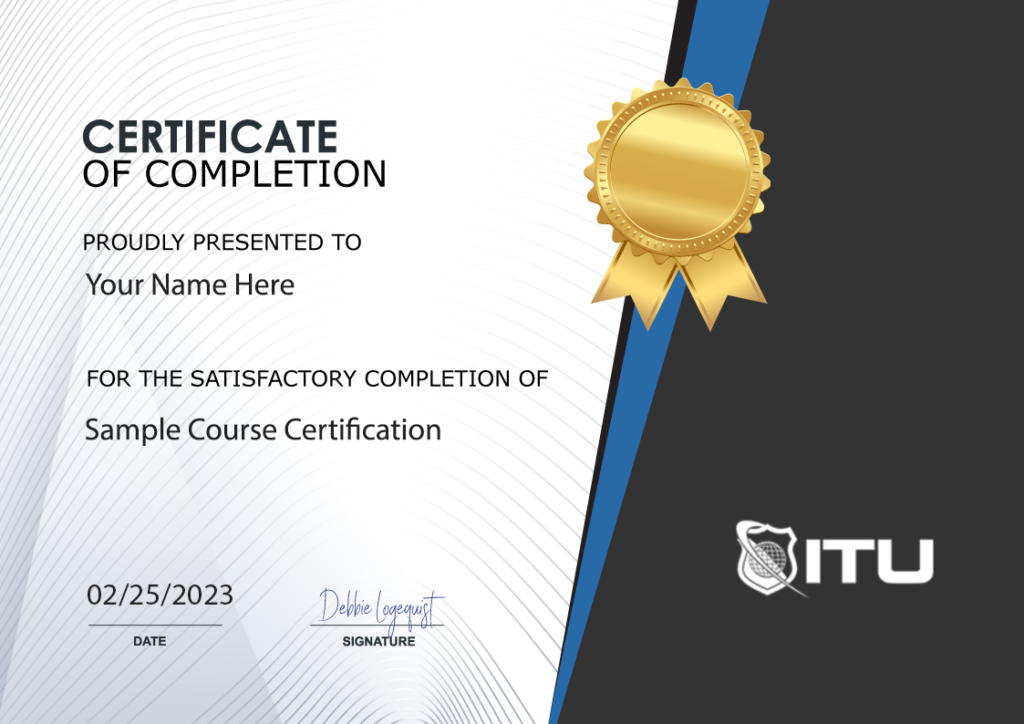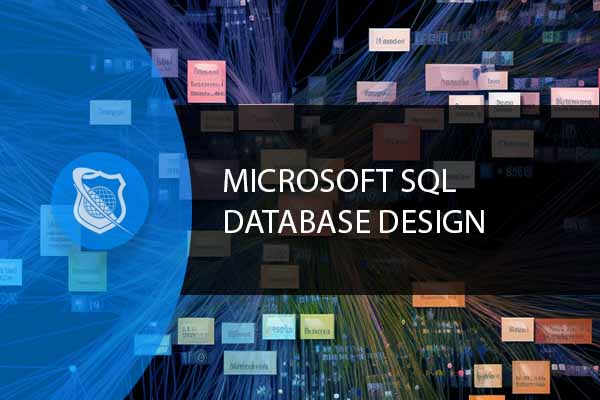Microsoft SQL Database Design
This Microsoft SQL Server Database Design course emphasizes the skills needed to design high-functioning databases in SQL Server. Not only will you learn about the fundamentals and resources required for an efficient database, but also gain insight and skill into tables, data accuracy and indexes. Plus, we explore essential programming techniques, file storage solutions and full-text search capabilities.
Included In This Course



Closed Captions



Certificate of Completion
Course Description for Microsoft SQL Server 2019 Database Design
This comprehensive course on Microsoft SQL Server 2019 Database Design is designed to provide a thorough understanding of database architecture, table design, data integrity enforcement, indexing, and advanced database programming. Whether you are new to SQL Server or looking to deepen your knowledge, this course offers a balanced mix of theoretical concepts and practical applications.
Throughout the course, you will learn about creating and altering tables, understanding data types and schemas, enforcing data domain and referential integrity, and implementing various types of indexes. Additionally, you will gain hands-on experience with stored procedures, functions, triggers, BLOB and FILESTREAM data, full-text search, and the differences between on-premises and Azure SQL deployments. By the end of this course, you will be equipped with the skills needed to design and manage efficient, scalable, and secure SQL Server databases.
What You Will Learn in Microsoft SQL Server 2019 Database Design
By taking this course, you will gain a comprehensive set of skills and knowledge essential for SQL Server database design and management. The following key learning outcomes will ensure you are well-prepared for real-world database challenges:
- Understanding of database design principles and best practices.
- How to create, alter, and manage tables and schemas.
- Knowledge of data types and their appropriate usage.
- Enforcement of data domain, entity, and referential integrity.
- Implementation and optimization of various indexing strategies.
- Development of stored procedures, user-defined functions, and triggers.
- Handling and storing BLOB and FILESTREAM data.
- Conducting full-text searches with catalogs and indexes.
- Comparing and contrasting on-premises SQL Server and Azure SQL options.
Who This Microsoft SQL Server 2019 Database Design Course is For
This course is designed for a wide range of individuals who are interested in mastering SQL Server database design and management. The target audience includes:
- Database administrators looking to enhance their SQL Server skills.
- Developers seeking to understand database design and optimization.
- IT professionals transitioning to database roles.
- Students and beginners interested in database management.
- Data analysts and engineers who work with SQL Server databases.
Possible Jobs You Can Get With This Knowledge of Microsoft SQL Server 2019 Database Design
Mastering SQL Server 2019 database design opens up numerous career opportunities across various industries. With the skills acquired from this course, you can pursue roles such as:
- Database Administrator
- SQL Developer
- Data Engineer
- Business Intelligence Analyst
- Data Architect
- IT Consultant
Average Industry Salaries for People with Skills in Microsoft SQL Server 2019 Database Design
Professionals with expertise in SQL Server database design can expect competitive salaries. Here are some average salary ranges for relevant job titles:
- Database Administrator: $70,000 – $120,000
- SQL Developer: $75,000 – $115,000
- Data Engineer: $80,000 – $130,000
- Business Intelligence Analyst: $70,000 – $110,000
- Data Architect: $90,000 – $140,000
Get Started Today with Microsoft SQL Server 2019 Database Design
Don’t miss out on the opportunity to advance your career and enhance your skills in database design and management. Enroll in our Microsoft SQL Server 2019 Database Design course today and take the first step towards becoming an expert in SQL Server. Gain practical knowledge, hands-on experience, and the confidence to tackle real-world database challenges. Start learning now and unlock your potential!
You Might Also Be Interested In Our Comprehensive SQL Courses
- Microsoft SQL Database Design
- Introduction to Microsoft Power BI
- Querying SQL Server With T-SQL – Master The SQL Syntax
- Microsoft SQL Database Administration : Optimize Your SQL Server Skills
- Microsoft Server – SQL Data Analysis
- Microsoft SQL – SQL Big Data
- SSAS : Microsoft SQL Server Analysis Services
Key Term Knowledge Base: Key Terms Related to Microsoft SQL Server 2019 Database Design
Understanding the key terms related to Microsoft SQL Server 2019 Database Design is crucial for anyone looking to work with or deepen their knowledge in this area. This technology is integral to managing and organizing large amounts of data efficiently. Knowing these terms not only aids in grasping the course material but also equips you with the language needed to communicate effectively in the field of database design and management.
| Term | Definition |
|---|---|
| SQL Server | A relational database management system developed by Microsoft, designed to handle a wide range of data processing applications. |
| Database Design | The process of defining the structure, storage, and retrieval of data in a database. |
| Tables | The basic storage unit in SQL Server where data is stored in rows and columns. |
| Data Types | The attributes that define the kind of data that can be stored in a table column, such as integers, text, dates, etc. |
| Schemas | Structures that help organize database objects like tables, procedures, and views, often used for managing permissions. |
| Data Integrity | Ensuring data is accurate and consistent throughout its lifecycle in the database. |
| Indexes | Database objects that improve the speed of data retrieval operations on a database table. |
| Clustered Index | A type of index where the row data is stored in the order of the index keys. |
| Nonclustered Index | An index structure separate from the data rows, allowing more indexes per table. |
| Stored Procedures | A set of SQL statements saved in the database that perform a specific task. |
| User-Defined Functions | Functions created by users that can be used in SQL statements. |
| Triggers | A special kind of stored procedure that automatically executes in response to certain events on a particular table or view. |
| BLOB (Binary Large Object) | A large binary data type used to store images, documents, audio, etc., in the database. |
| FILESTREAM | A SQL Server feature used to store and manage unstructured data (like BLOBs) more efficiently. |
| Full-Text Search | A feature that allows efficient and effective search operations on text-based data in SQL databases. |
| Azure SQL Database | A fully managed relational cloud database service provided by Microsoft Azure. |
| OLTP (Online Transaction Processing) | A class of systems that facilitate and manage transaction-oriented applications. |
| OLAP (Online Analytical Processing) | A category of software that allows users to analyze information from multiple database systems at the same time. |
| T-SQL (Transact-SQL) | An extension of SQL used in Microsoft SQL Server. |
| Data Domain Integrity | Constraints that enforce valid entries for a given column by restricting the type, format, or range of possible values. |
| Entity Integrity | Ensuring each row in a table is uniquely identifiable. |
| Referential Integrity | A system of rules that ensure relationships between tables remain consistent. |
| Heaps | A table without a clustered index. |
| Composite Indexes | Indexes that are based on more than one column of a table. |
| SQL Server Management Studio (SSMS) | An integrated environment for managing SQL Infrastructure. |
| Normalization | The process of organizing data to minimize redundancy. |
| Denormalization | The process of attempting to optimize the read performance of a database by adding redundant data. |
| Primary Key | A column, or a set of columns, that uniquely identifies each row in a table. |
| Foreign Key | A field (or fields) in one table, that uniquely identifies a row of another table. |
| Query | A request for data or information from a database table or combination of tables. |
| Relational Database | A database structured to recognize relations among stored items of information. |
| SQL (Structured Query Language) | A standard language for storing, manipulating, and retrieving data in databases. |
| Data Warehouse | A system used for reporting and data analysis, and is considered a core component of business intelligence. |
| ETL (Extract, Transform, Load) | A process in database usage and especially in data warehousing that involves extracting data from outside sources, transforming it to fit operational needs, and loading it into the end target. |
| Data Mining | The process of discovering patterns in large data sets. |
| Backup | The process of creating a copy of data on a database to safeguard against loss. |
| Replication | A set of technologies for copying and distributing data and database objects from one database to another and then synchronizing between databases to maintain consistency. |
| Partitioning | The database process where very large tables are divided into multiple smaller, more manageable pieces, yet still being treated as a single table. |
| ACID (Atomicity, Consistency, Isolation, Durability) | A set of properties that guarantee database transactions are processed reliably. |
| Data Model | An abstract model that organizes data elements and standardizes how they relate to one another and to the properties of real-world entities. |
| Transaction | A sequence of database operations that are treated as a single unit. |
| Cursor | A database object that allows retrieval of data from a result set one row at a time. |
| View | A virtual table based on the result-set of an SQL statement. |
| Locking | A mechanism used by databases to control access to data by transactions. |
| Database Schema | The structure of a database system, described in a formal language. |
| SQL Injection | A code injection technique used to attack data-driven applications. |
| Database Administrator (DBA) | A person responsible for the installation, configuration, upgrade, administration, monitoring, and maintenance of databases in an organization. |
| Data Lake | A storage repository that holds a vast amount of raw data in its native format until it is needed. |
| Microsoft SQL Server Analysis Services (SSAS) | An online analytical processing and data mining tool in Microsoft SQL Server. |
| Microsoft SQL Server Integration Services (SSIS) | A platform for building enterprise-level data integration and data transformations solutions. |
| Microsoft SQL Server Reporting Services (SSRS) | A server-based report generating software system from Microsoft. |
Frequently Asked Questions About Microsoft SQL Server Database Design
What topics are covered in the Microsoft SQL Server 2019 Database Design course?
The course covers various topics including designing and building tables, enforcing data integrity, indexing, stored procedures, functions, triggers, BLOB and FILESTREAM data, full-text search, and the differences between on-premises and Azure SQL deployments.
Who is the target audience for the Microsoft SQL Server 2019 Database Design course?
The course is designed for database administrators, developers, IT professionals transitioning to database roles, students, beginners, data analysts, and engineers who work with SQL Server databases.
What skills will I gain from the Microsoft SQL Server 2019 Database Design course?
You will gain skills in database design principles, creating and managing tables and schemas, understanding data types, enforcing data integrity, implementing indexing strategies, developing stored procedures, functions, triggers, handling BLOB and FILESTREAM data, and conducting full-text searches.
What career opportunities are available with expertise in SQL Server 2019 database design?
With expertise in SQL Server 2019 database design, you can pursue roles such as Database Administrator, SQL Developer, Data Engineer, Business Intelligence Analyst, Data Architect, and IT Consultant.
What are the average salaries for professionals with skills in SQL Server 2019 database design?
Average salaries for professionals with skills in SQL Server 2019 database design range from $70,000 to $140,000 depending on the role, such as Database Administrator, SQL Developer, Data Engineer, Business Intelligence Analyst, and Data Architect.
Blogs of Interest Related to This Course
Proudly DisplayYour Achievement
Upon completion of your training, you’ll receive a personalized certificate of completion to help validate to others your new skills.
SQL Server 2019 Database Design Course Content
Module 1 - Designing and Building Tables
- 1.1 Course Introduction
- 1.2 Module 1 Introduction
- 1.3 Introduction to Database Design
- 1.4 Creating Tables
- 1.5 Data Types
- 1.6 Schemas
- 1.7 Altering Tables
Module 2 - Enforcing Data Integrity
- 2.1 Module 2 Introduction
- 2.2 Introduction to Data Integrity
- 2.3 Data Domain Integrity
- 2.4 Implementing Data Domain Integrity
- 2.5 Implementing Entity and Referential Integrity
Module 3 - Indexing
- 3.1 Module 3 Introduction
- 3.2 Core Indexing Concepts
- 3.3 Heaps, Clustered, and Nonclustered Indexes
- 3.4 Data Types and Indexes
- 3.5 Single Column and Composite Indexes
Module 4 - Stored Procedures, Functions, and Triggers
- 4.1 Module 4 Introduction
- 4.2 Introduction to Database Programming
- 4.3 Creating Stored Procedures
- 4.4 Creating User-Defined Functions
- 4.5 Creating Triggers
Module 5 - Blob and Filestream Data
- 5.1 Module 5 Introduction
- 5.2 Introduction to Binary Data
- 5.3 Considerations for BLOB data
- 5.4 FILESTREAM Example
- 5.5 File Table Example
Module 6 - Full-Text Search
- 6.1 Module 6 Introduction
- 6.2 Introduction to Full-Text Search
- 6.3 Full-Text Catalogs
- 6.4 Full-Text Indexes
- 6.5 Full-Text Queries
Module 7 - Azure vs On-Prem
- 7.1 Module 7 Introduction
- 7.2 SQL Server on Azure VM
- 7.3 Azure Managed SQL Instance
- 7.4 Azure SQL Database
- 7.5 Course Wrap Up
Your Training Instructor
James is a full-stack developer with over 40 years of experience. He has developed applications across all major industries and for Fortune 100 companies as well as local small businesses. James has also been teaching technology courses for over 20 years. In addition to his extensive background in technology, he has also worked as a professional opera singer.

Subscribe To All-Access
Lock In $16.99 / Month Forever
Access this course and over 3,000 hours of focused IT training. Start your first month for only $1.00. Then lock in only $16.99 / month for life.
- Get Every Course
- Free Updates / New Content Added
- 3,000+ Hours of Training
- Price Lock Guarantee
- Games / Flashcards
- 21,000+ Practice Questions
$49.99 $16.99 Monthly
$49.00



